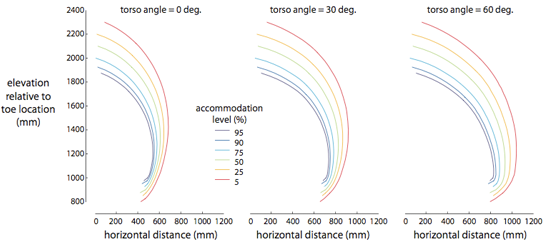Standing reach envelopes are important tools for the design of industrial and vehicle environments. Previous work in this area has focussed on manikin-based (where a few manikins are used to simulate individuals reaching within the region of interest) and population-based (where data are gathered on many individuals reaching in a constrained environment) approaches. Each of these methods has merits and shortfalls. The current work bridges the manikin- and population-based approaches to assessing reach by creating population models using kinematic simulation techniques driven by anthropometric data. The approach takes into account body dimensions, balance, and postural cost to create continuous models that can be used to assess designs with respect to both maximal and submaximal reaches. Cost is quantified as the degree to which the torso is involved in the reach, since the inclination of the torso is a good measure of lower-back load and may be related to subjective reach difficulty. A simplified planar analysis is presented to illustrate the modeling approach.

